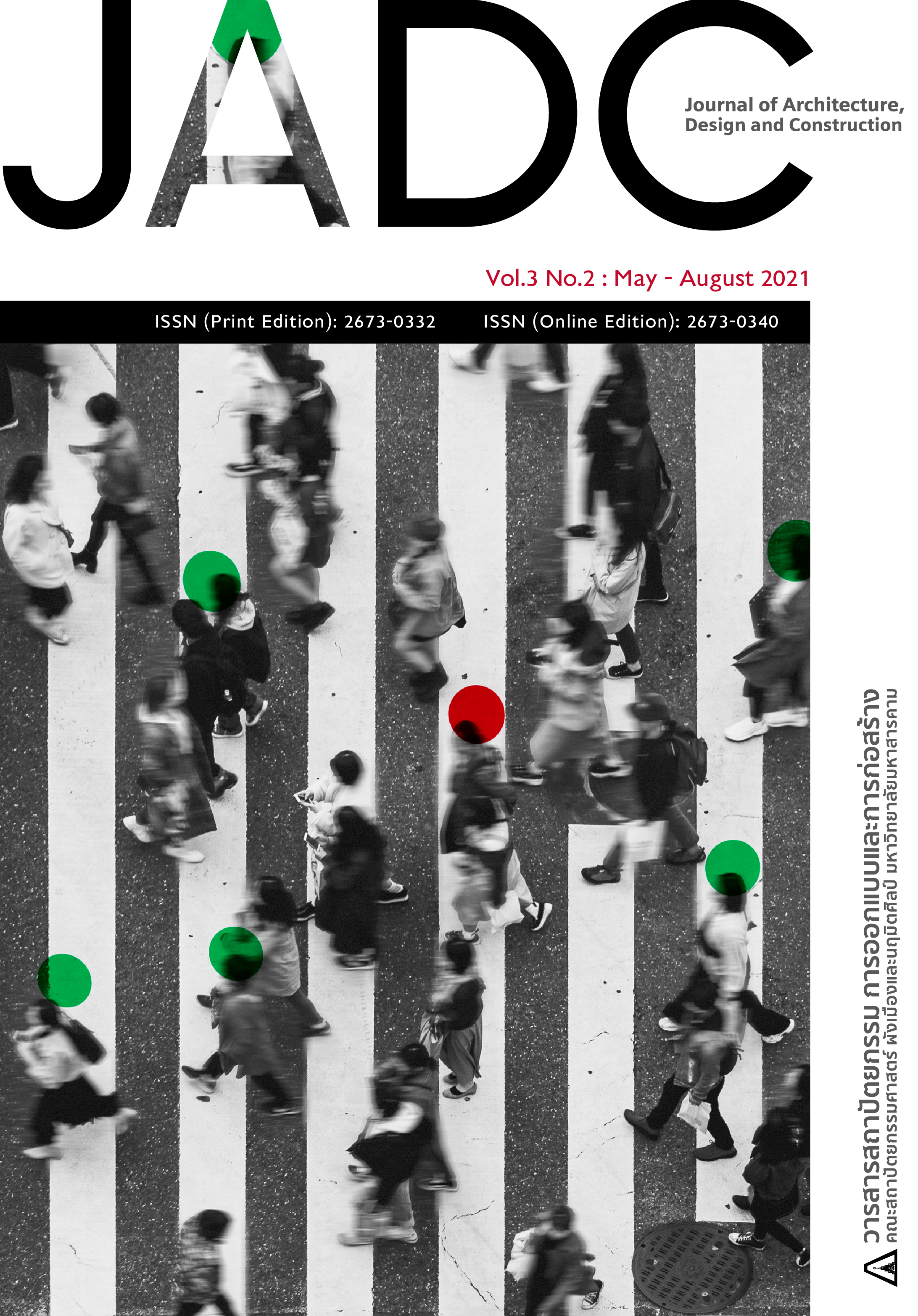Risk factors influential impact project failure of railroads construction in Thailand
Main Article Content
บทคัดย่อ
งานวิจัยนี้ต้องการศึกษาปัจจัยความเสี่ยงที่มีอิทธิพลต่อความล้มเหลวของโครงการก่อสร้างคมนาคมขนส่งระบบรางในประเทศไทย โดยเริ่มศึกษาปัจจัยที่มีอิทธิพลจากการทบทวนวรรณกรรมเพื่อให้ได้ข้อมูลทั้งทางด้านทฤษฎี จากนั้นทำการวัดความเที่ยงตรงเชิงเนื้อหาจากผู้เชี่ยวชาญ 5 ท่าน ที่มีความรู้และประสบการณ์ด้านที่เกี่ยวข้องกับการบริหารความเสี่ยงโครงการ โดยการตัดตัวแปรที่ไม่เกี่ยวข้องออกไป ซึ่งจะทำให้ทราบถึงปัจจัยที่มีอิทธิพลอย่างแท้จริง จากนั้นนำมาสร้างเป็นแบบสอบถามและทำการปรับปรุงให้เหมาะสม ใช้เก็บข้อมูลกับหน่วยงานที่เกี่ยวข้องกับการบริหารความเสี่ยงโครงการก่อสร้างคมนาคมขนส่งระบบรางในประเทศไทย ต่อจากนั้นข้อมูลจะถูกวิเคราะห์ด้วยโปรแกรม SPSS เพื่อหาค่าองค์ประกอบปัจจัย ค่าความผันแปร และการวิเคราะห์ถึงความสัมพันธ์ของตัวแปรอิสระ ผลการวิเคราะห์พบว่าปัจจัยความล้มเหลวของโครงการก่อสร้างคมนาคมขนส่งระบบรางในประเทศไทยสามารถแบ่งได้ 4 กลุ่ม โดยสามารถอธิบายความแปรผันทั้งหมด 69.03% ได้แก่ 1) ด้านการดำเนินงาน 2) ด้านการสื่อสารปฏิบัติงานในโครงการ 3) ด้านข้อตกลงที่กำหนดไว้ของคู่สัญญา และ 4) ด้านความผันผวนของอัตราแลกเปลี่ยนอัตราดอกเบี้ย โดยองค์ประกอบที่มีความน้ำหนักองค์ประกอบมากที่สุดที่ผู้บริหารควรให้ความสำคัญเป็นอันดับแรก คือ ด้านการสื่อสารปฏิบัติงานในโครงการ ซึ่งประโยชน์ที่คาดว่าจะได้รับจากงานวิจัยนี้คือ ผู้ที่เกี่ยวข้องกับการบริหารจัดการโครงการด้านคมนาคมขนส่งระบบราง เช่น ผู้จัดการโครงการ นักบริหารโครงการ และผู้ปฏิบัติงาน สามารถนำปัจจัยเหล่านี้ไปเป็นแนวทางในขั้นตอนของการปฏิบัติงานจริง โดยเน้นให้ความสำคัญกับปัจจัยที่มีอิทธิพลเหล่านี้มาพิจารณาก่อน เพื่อให้การบริหารความเสี่ยงโครงการสำเร็จตามวัตถุประสงค์
Downloads
Article Details
บทความที่ได้รับการตีพิมพ์เป็นลิขสิทธิ์ของวารสารสถาปัตยกรรม การออกแบบและการก่อสร้าง คณะสถาปัตยกรรมศาสตร์ ผังเมืองและนฤมิตศิลป์ มหาวิทยาลัยมหาสารคาม
เอกสารอ้างอิง
การรถไฟแห่งประเทศไทย (2560). การบริหารความเสี่ยง รายงานประจำปี 2560
การรถไฟฟ้าขนส่งมวลชนแห่งประเทศไทย (2559). คู่มือการบริหารความเสี่ยง (ฉบับปี 2556-2559).
การรถไฟแห่งประเทศไทย (2561). การบริหารความเสี่ยง ปัจจัยความเสี่ยง (รายงานประจำปี 2561).
การรถไฟแห่งประเทศไทย (2561). รายงานผลการดำเนินงานของการรถไฟฟ้าขนส่งมวลชนแห่งประเทศไทย ในปีงบประมาณ 2561 นโยบายของคณะกรรมการและโครงการและแผนงานในอนาคต.
ชายรอง กิมเฮียะ, อุดมวิทย์ ไชยสกุลเกียรติ.(2563). ปัจจัยที่มีผลกระทบต่อความล่าช้าของงานก่อสร้าง: กรณีศึกษาโครงการรถไฟฟ้าสายสีชมพู (แคราย มีนบุรี).
ธนายุทธ ไชยธงรัตน์, ณรงค์ เหลืองบุตรนาค, & พีร์นิธิ อักษร. (2018). การวิเคราะห์องค์ประกอบ เชิงสำรวจของการทุจริตคอร์รัปชันในการจัดซื้อจัดจ้างภาครัฐ. Engineering Journal of Research and Development, 29(3), 5-14.
นิทัศน์ แผ้ววัด (2556). การระบุความเสี่ยงที่สำคัญในโครงการก่อสร้างอาคารสูงในกรุงเทพมหานคร มุมมองของผู้มีส่วนได้ส่วนได้ส่วนเสีย. การประชุมวิชาการวิศวกรรมโยธาแห่งชาติ ครั้งที่18
พัชรปรัตถ์ขาว สะอาด. (2561). การพัฒนาส่วนต่อขยายระบบรางในจังหวัดเชียงใหม่เพื่อการ เดินทางโดยระบบขนส่งสาธารณะที่มีประสิทธิภาพ. มหาวิทยาลัยศรีปทุม.
สถาบันการขนส่ง จุฬาลงกรณ์มหาวิทยาลัย. (2559). การศึกษาปัจจัยภาครัฐและกฏหมายในการพัฒนาการขนส่งสินค้าทางรถไฟในประเทศไทย
สำนักงานนโยบายและแผนการขนส่งและจราจร (สนข.) กระทรวงคมนาคม (2559). ยุทธศาสตร์การพัฒนาระบบคมนาคมขนส่งของไทย ระยะ 20 ปี (พ.ศ. 2560-2579).
หยงลักษณ์ สุริยเดชวงค์ (2557). การระบุและวิเคราะห์ความเสี่ยงในโครงการก่อสร้างอาคารผู้โดยสาร สนามบิน: กรณีศึกษาโครงการสนามบินสุวรรณภูมิและโกลกาต้า ปริญญาปรัชญาสาขาวิชาวิศวกรรมก่อสร้างและการจัดการ.สถาบันเทคโนโลยีพระจอมเกล้าเจ้าคุณทหารลาดกระบัง
อัฐนันท์ ชลายนนาวิน (2560). แนวทางการบริหารความเสี่ยงของการรถไฟแห่งประเทศไทยที่มีต่อโครงการก่อสร้างรถไฟทางคู่ ช่วงหัวหิน ประจวบคีรีขันธ์
Acharya, N. K., Dai Lee, Y., & Im, H. M. (2006). Conflicting factors in construction projects: Korean perspective. Engineering, construction and architectural management.
Adnan E, Jaser Abu M., (2008). Risk Management in Building Projects: Owners’ Perspective Civil Eng. Dept., Faculty of Engineering, Vol.16, No. 1.p. 95-123, ISSN 1726-6807, http://www.iugaza.edu.ps/ara/research/
Chaichana (2560). Using multivariate statistics for research : designing, analyzing, and interpreting, Bangkok: Chulalongkorn University Printing House.
Cheng S, Hamzah A.(2013). The Identification and Management of Major Risks in the Malaysian Construction Industry. Journal of construction in Developing Countries.p.18-32.
Field, A. (2013). Discovering statistics using IBM SPSS statistics. sage.
Ghosh, S., & Jintanapakanont, J. (2004). Identifying and assessing the critical risk factors in an underground rail project in Thailand: a factor analysis approach. International Journal of Project Management, 22(8), 633-643.
Hair, J. F., Black, W. C., Babin, B. J., Anderson, R. E., & Tatham, R. L. (2006). Multivariate data analysis sixth edition Pearson education. New Jersey, 42-43.
Kumar, L., Jindal, A., & Velaga, N. R. (2018). Financial risk assessment and modelling of PPP based Indian highway infrastructure projects. Transport Policy, 62, 2-11.
Mahasirikul, Narongdet, Preenithi Aksorn, and Wuttipong Kusonkhum. (2021). “Driving Speed and Hazardous Location in Construction Work Zone Case of Highway 2 Hin Lat-Non-Sa At.” International Journal of GEOMATE 20(80): 143–51
Masrom, M. A. N., Abd Rahim, M. H. I., Mohamed, S., Chen, G. K., & Yunus, R. (2015). Successful criteria for large infrastructure projects in Malaysia. Procedia Engineering, 125, 143-149.
Mousavi S, Tavakkoli M, Azaron A, Mojtahedi, Hashemi H. (2011). Risk assessment for highway projects using jackknife technique. p.5514–5524.
Peetawan, W., & Suthiwartnarueput, K. (2018). Identifying factors affecting the success of rail infrastructure development projects contributing to a logistics platform: A Thailand case study. Kasetsart Journal of Social Sciences, 39(2), 320-327.
Pinto, J. K., & Mantel, S. J. (1990). The causes of project failure. IEEE transactions on engineering management, 37(4), 269-276.
PMI (2013). A. Guide to the project management body of knowledge (PMBOK guide). Project Management Institute., Vol. 5.
Pujinda, S., & Rakkwamsuk, E. (2019). Achievement of Project management of The Mass Rapid Transit System in Bangkok Metropolitan Area. Case Study: Mass Rapid Transit Authority of Thailand (MRTA). Mahachula Academic Journal, 6(2), 125-141.
Pranee (2016). Finding quality of measurement and evaluation tools, Yala: Yala Rajabhat University.
Raz, T., Shenhar, A. J., & Dvir, D. (2002). Risk management, project success, and technological uncertainty. R&d Management, 32(2), 101-109.
Standard, B. (2009). Railway applications. Track. Concrete sleepers and bearers. Prestressed monoblock sleepers.
Teller, J., & Kock, A. (2013). An empirical investigation on how portfolio risk management influences project portfolio success. International Journal of Project Management, 31(6), 817-829..
Wiratchai, N. (1999). LISREL model: Statistical analysis for research. Bangkok: Faculty of Education, Chulalongkorn University.
Yuan, T., Xiang, P., Li, H., & Zhang, L. (2020). Identification of the main risks for international rail construction projects based on the effects of cost-estimating risks. Journal of Cleaner Production, 274, 122904.
Zhao, X., Hwang, B. G., & Yu, G. S. (2013). Identifying the critical risks in underground rail international construction joint ventures: Case study of Singapore. International Journal of Project Management, 31(4), 554-566..
Zidane, Y., & Andersen, B. (2018). Causes of delay and their cures in major Norwegian projects.
Zou, P. X., Wang, S., & Fang, D. (2008). A life‐cycle risk management framework for PPP infrastructure projects. Journal of financial management of property and construction.


